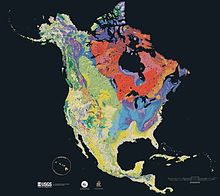First continents
Geologic map of North America, color-coded by age. The reds and pinks indicate rock from the Archean.
Mantle convection, the process that drives plate tectonics, is a result of heat flow from the Earth's interior to the Earth's surface. It involves the creation of rigid tectonic plates at mid-oceanic ridges. These plates are destroyed by subduction into the mantle at subduction zones. During the early Archean (about 3.0 Ga) the mantle was much hotter than today, probably around 1,600 °C (2,910 °F),so convection in the mantle was faster. Although a process similar to present-day plate tectonics did occur, this would have gone faster too. It is likely that during the Hadean and Archean, subduction zones were more common, and therefore tectonic plates were smaller.
The initial crust, formed when the Earth's surface first solidified, totally disappeared from a combination of this fast Hadean plate tectonics and the intense impacts of the Late Heavy Bombardment. However, it is thought that it was basaltic in composition, like today's oceanic crust, because little crustal differentiation had yet taken place.:258 The first larger pieces of continental crust, which is a product of differentiation of lighter elements during partial melting in the lower crust, appeared at the end of the Hadean, about 4.0 Ga. What is left of these first small continents are called cratons. These pieces of late Hadean and early Archean crust form the cores around which today's continents grew.
The oldest rocks on Earth are found in the North American craton of Canada. They are tonalites from about 4.0 Ga. They show traces of metamorphism by high temperature, but also sedimentary grains that have been rounded by erosion during transport by water, showing that rivers and seas existed then.Cratons consist primarily of two alternating types of terranes. The first are so-called greenstone belts, consisting of low-grade metamorphosed sedimentary rocks. These "greenstones" are similar to the sediments today found in oceanic trenches, above subduction zones. For this reason, greenstones are sometimes seen as evidence for subduction during the Archean. The second type is a complex of felsicmagmatic rocks. These rocks are mostly tonalite, trondhjemite or granodiorite, types of rock similar in composition to granite (hence such terranes are called TTG-terranes). TTG-complexes are seen as the relicts of the first continental crust, formed by partial melting in basalt.:Chapter 5





Comments
Post a Comment